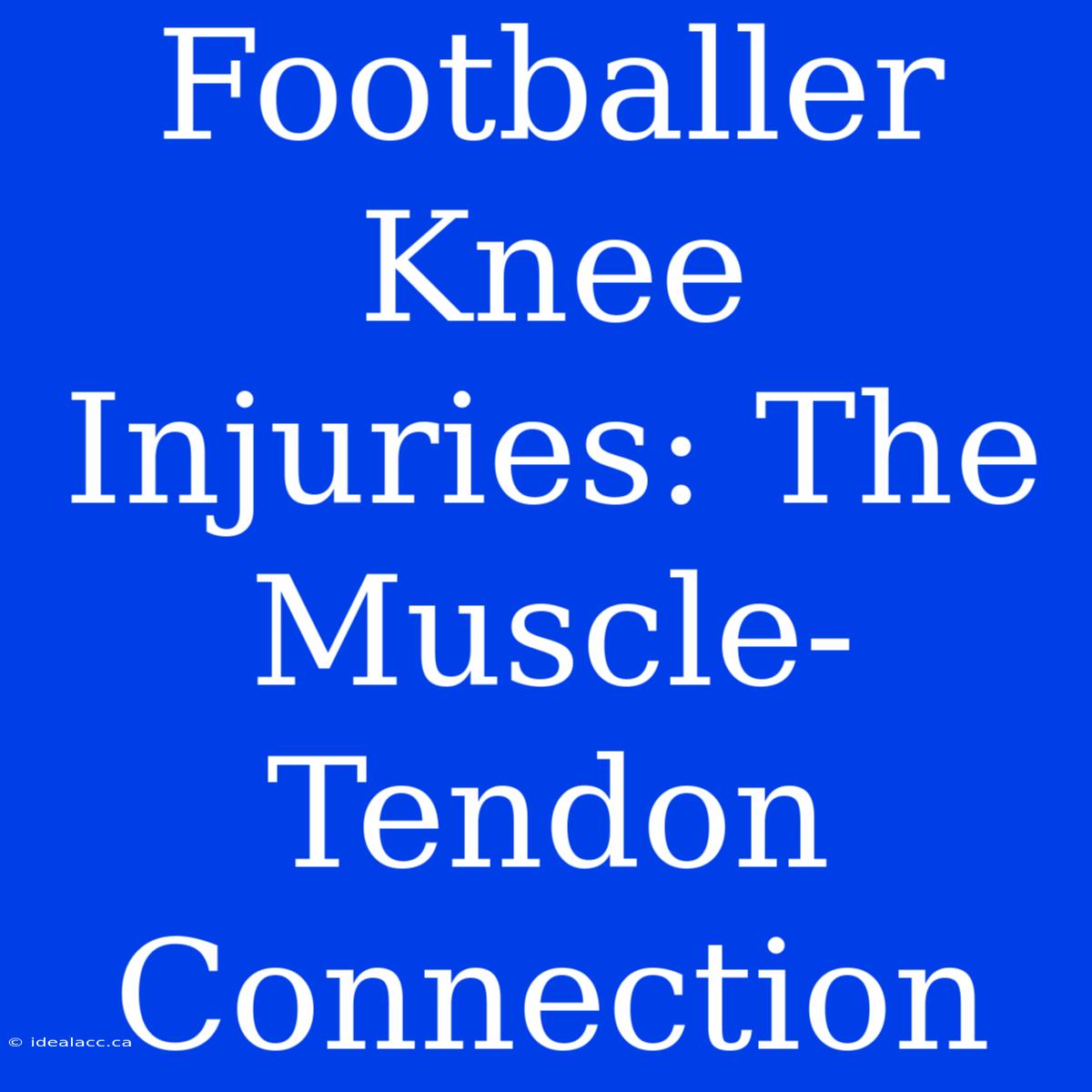Footballer Knee Injuries: The Muscle-Tendon Connection – Unlocking the Secrets to Prevention and Recovery
Are you curious about the intricate relationship between muscles and tendons and how it impacts footballers' knee injuries? Understanding this complex connection is crucial for both injury prevention and effective recovery.
Editor Note: This article dives into the intricacies of footballer knee injuries, exploring the vital connection between muscles and tendons.
This topic is crucial because knee injuries are a common occurrence in football, often impacting performance and career longevity. By understanding the muscle-tendon relationship, athletes, coaches, and medical professionals can implement strategies to minimize risk and optimize recovery. This article delves into the mechanics of knee injuries, the role of muscles and tendons, and evidence-based approaches for prevention and rehabilitation.
Analysis: We've researched and analyzed extensive scientific literature on the subject, combining insights from leading sports medicine experts, biomechanics specialists, and experienced football professionals to provide a comprehensive overview.
Key Takeaways
| Key Aspect | Description |
|---|---|
| Muscle-Tendon Unit | The dynamic interplay between muscles and tendons, crucial for movement and stability. |
| Biomechanics of the Knee | Understanding the forces and movements that place stress on the knee joint. |
| Common Football Knee Injuries | Exploring the most frequent types of injuries, including ACL tears, MCL sprains, and meniscus tears. |
| Muscle Strength and Conditioning | How targeted exercises enhance muscle strength and tendon resilience, preventing injury. |
| Rehabilitation and Recovery | The critical role of physiotherapy, guided exercise, and proper training to restore function and prevent re-injury. |
Footballer Knee Injuries
The knee joint is a complex structure responsible for supporting the weight of the body and facilitating movement. Footballers, due to the high-impact nature of the sport, are susceptible to various knee injuries. Understanding the muscle-tendon connection is essential to grasp the underlying mechanisms.
The Muscle-Tendon Unit:
This unit is responsible for generating force and controlling movement. Muscles, composed of contractile tissue, generate the power for movement. Tendons, strong connective tissue, attach muscles to bones, transmitting this force.
Biomechanics of the Knee:
During football, the knee is subjected to various forces and movements, including:
- Rotation: Twisting movements, such as when pivoting or changing direction.
- Extension and Flexion: Straightening and bending movements.
- Impact: The forceful contact during tackles, collisions, and landing from jumps.
Common Football Knee Injuries:
The most common football knee injuries are:
- Anterior Cruciate Ligament (ACL) Tear: A common injury resulting from forceful twisting or impact, leading to instability.
- Medial Collateral Ligament (MCL) Sprain: Caused by a direct impact to the outside of the knee, causing pain and swelling.
- Meniscus Tear: A tear in the cartilage that acts as a shock absorber within the knee joint, often due to twisting or impact.
Muscle Strength and Conditioning
Strong muscles and tendons are essential for preventing knee injuries in footballers.
- Targeted Exercises: Exercises that strengthen the muscles surrounding the knee joint, including quadriceps, hamstrings, and glutes, are crucial.
- Proprioception and Balance: Exercises that improve proprioception (body awareness) and balance help control movement and prevent falls, thus reducing injury risk.
Quadriceps:
The quadriceps are the primary extensor muscles of the knee, responsible for straightening the leg. They play a crucial role in providing stability and preventing anterior translation of the tibia (shin bone).
Facets:
- Role: Knee extension, stability, and anterior translation prevention.
- Examples: Squats, lunges, leg presses.
- Risks: Imbalance with the hamstrings can increase ACL injury risk.
- Mitigation: Ensure a balanced strength program with equal emphasis on quadriceps and hamstring exercises.
Hamstrings:
The hamstrings are the primary flexor muscles of the knee, responsible for bending the leg. They provide crucial control during dynamic movements, reducing anterior tibial translation and preventing ACL injuries.
Facets:
- Role: Knee flexion, stability, and limiting anterior tibial translation.
- Examples: Hamstring curls, deadlifts, good mornings.
- Risks: Weakness or imbalance with quadriceps can lead to anterior tibial translation and increased ACL risk.
- Mitigation: Focus on exercises that strengthen hamstrings and address any imbalances with quadriceps.
Glutes:
The gluteal muscles are the powerful hip extensors, responsible for hip extension and rotation. They play a critical role in stabilizing the pelvis and controlling knee movement, reducing stress on the knee joint.
Facets:
- Role: Hip extension, pelvic stability, and controlling knee movement.
- Examples: Hip thrusts, glute bridges, side lunges.
- Risks: Weak glutes can lead to increased knee stress and instability.
- Mitigation: Include exercises that target gluteal muscles, ensuring adequate strength and activation.
Rehabilitation and Recovery
Proper rehabilitation is essential after a knee injury to restore function and prevent re-injury.
- Physiotherapy: Specialized exercises and manual therapy are crucial for regaining range of motion, strength, and stability.
- Progressive Loading: Gradual increases in activity levels and intensity help the knee joint adapt and strengthen.
- Proprioception Training: Exercises that improve body awareness and balance enhance coordination and control, minimizing re-injury risk.
Key Takeaways:
| Key Aspect | Description |
|---|---|
| Functional Exercises: Activities that mimic the movements of football, incorporating agility drills and plyometrics. | |
| Sports-Specific Training: Progressive return to football activities, ensuring proper form and gradual increases in intensity. | |
| Education and Self-Management: Players should understand their injury, engage in self-care, and follow their rehabilitation plan diligently. |
Conclusion
The muscle-tendon connection plays a pivotal role in football knee injuries. Understanding this intricate relationship is crucial for both preventing injuries and optimizing recovery. By implementing targeted strength and conditioning programs, improving proprioception, and following evidence-based rehabilitation protocols, footballers can minimize their risk of knee injuries and maintain their performance.
Remember, a proactive approach to injury prevention and recovery is essential for footballers to thrive in the demanding world of football.

